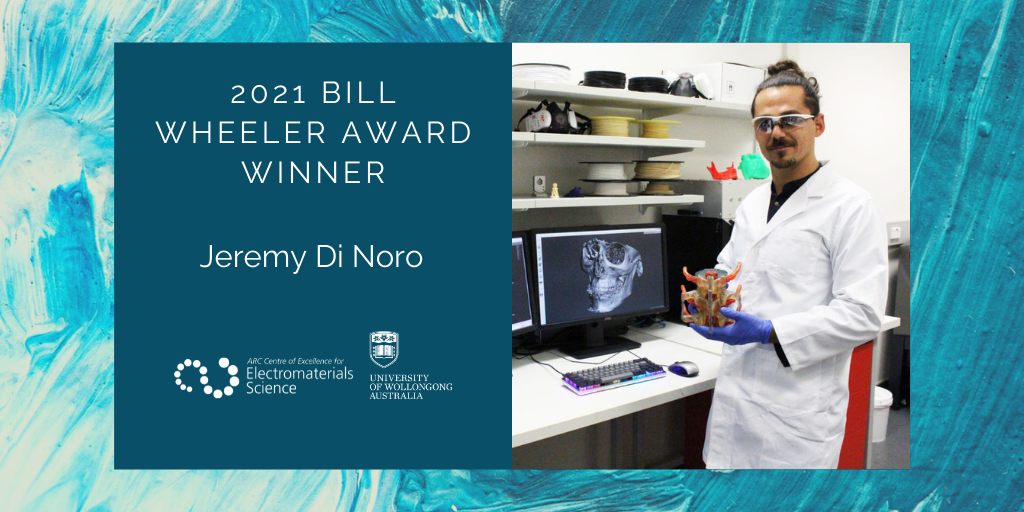News
3D printing bone tissue
Jun 28 2022
ACES affiliate and University of Wollongong (UOW) Biofabrication PhD student Jeremy Di Noro has been awarded this year’s Bill Wheeler Award.

Jeremy was recognised for best communicating the social impact of his research on patient-specific implants through 3D printing at last week’s virtual Bill Wheeler Symposium and Award. Supported by the Kiama Rotary Club, the award includes $2,000 in community-raised funds, which will help further his research.
The event is held each year in honour of the late Bill Wheeler, an active member of the Illawarra community who took a keen interest in new bionics research at UOW. The Symposium also featured a guest presentation from head and neck surgeon, A/Prof Bruce Ashford – as well as an update from last year’s award winner, Grishmi Rajbhandari.
We caught up with Jeremy on the back of winning the award to get his reaction and to find out a bit more about his research.
For some background, could you tell us about your PhD?
My PhD research is based at both the Intelligent Polymer Research Institute (IPRI) within UOW’s Innovation Campus and the Translational Research Initiative for Cell Engineering and Printing (TRICEP). I also work closely with industry partner Anatomics, a medical devices company down in Melbourne, to develop new ways of treating bone defects.
Current treatments fail to accurately replicate the function of the missing bone and through 3D printing, we can not only make individualised implants that perfectly fit but also match some of bones native physical properties, such as high porosity, strength, and flexibility.
To simplify the actual process, I’ve basically turned a laser engraver into a powder 3D printer. The laser draws patterns throughout a powder bed (made of biocompatible material) and fuses adjacent particles together in a defined region (< 1mm) – a roller adds more powder on top and the process continues until a 3D part is produced. The parts can be designed from a patient’s medical scans like MRI or CT, generating a patient-specific implant.
Congratulations on winning this year’s Bill Wheeler Award. What was your reaction when you found out you were going to be the winner?
Instant gratitude! It’s difficult in science (or any line of work) to realise the impact your work can have on society. But with awards like this, we can acknowledge it in a realistic context with support from the community.
What does winning this award mean to you?
It gives me hope and it motivates me to keep pushing into the unknown so we can continue to innovate and progress as a society. As A/Prof Ashford said during his talk at the symposium, ‘pressure is a privilege.’ It means recognition in a different context, arguably the most important, from a social perspective. Because, at the end of the day, we all work to try to benefit society.
What do you plan on doing with the funding you’ve won?
The funding will go directly into the registrations for virtual conferences on tissue engineering and scientific society memberships, so this research can be shared with the broader scientific community here in Australia and Internationally.
The award will also go towards finishing the bone 3D printer, so I can help push medicine forward. It’s not an individual effort that gets us there but the contributions of scientists, engineers, clinicians and patients as well as those like yourself, Sam, that put in the work to provide the platform to share and communicate this work to a broader audience. It’s a community effort.
The Symposium was obviously held virtually. How have you found adapting to such online workshops, particularly those where you have had to present your work?
It’s difficult but discomfort and adapting are key to progressing in life and science.
Well said! Thanks for your time, Jeremy – and congratulations on this achievement once again!
Thanks, Sam!
Read the full recap of the Bill Wheeler Symposium and Award here – and watch the replay of the event here.
If you would like to support the Bill Wheeler Award going forward, you can donate here.













